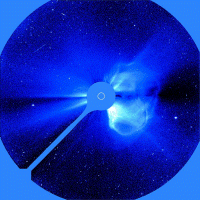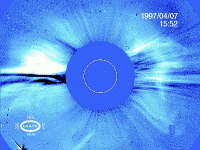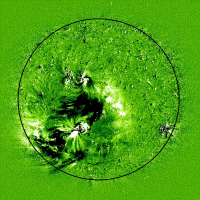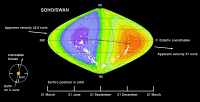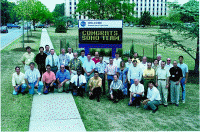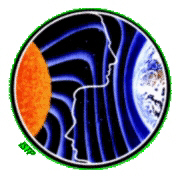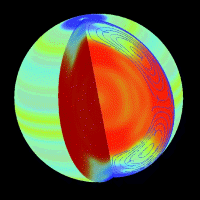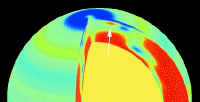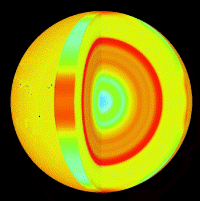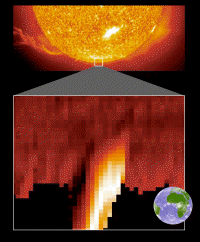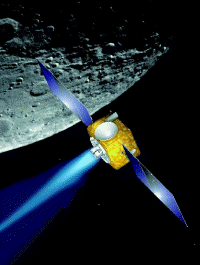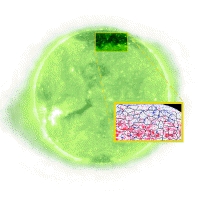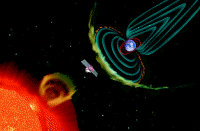SOHO: solar watchdog
When to warn the world of dangerous solar blasts
When people living in northern latitudes suffer electrical blackouts, for which neither the weather nor power companies are responsible, the one to blame is very likely the Sun. Blasts of gas from the Sun called mass ejections can cause magnetic storms, which stress power networks, affect navigation systems and may even send birds off course.
With SOHO's help, forecasts of severe space weather moving towards our planet are greatly improved so that engineers can be alert to the risk. From its vantage point, SOHO has an excellent view of the blasts of gas, which grow far larger than the Sun. If a mass ejection is seen as a halo around the Sun it may be heading straight for the Earth or it may be going away. To avoid false alarms, scientists looked for symptoms on the Sun's visible face associated with an earthwards mass ejection.
They found a marker for mass ejections in the Sun's lower atmosphere with SOHO's EIT telescope. It reveals spectacular shock waves propagating across the solar disk as a recoil effect from a mass ejection. If SOHO reports both a halo outburst and the corresponding signature on the face of the Sun, then space weather forecasters can more confidently alert the world to the risk of a magnetic storm.
Mankind's dependence on technologies vulnerable to solar disturbances has dramatically increased over the last decade. Occasionally solar flares send energetic particles - mainly protons - towards the Earth, too. They threaten orbiting astronauts and can seriously damage satellites. One of SOHO's great advantages over previous attempts to study solar proton events is that it can relate upheavals seen in the Sun's atmosphere to the energetic particles showing up in SOHO's own detectors, called COSTEP and ERNE.
|
| |
|
Jarmo Torsti | |
|
|
"Before SOHO, no one knew why some eruptions on the Sun drench us with damaging particles, while others don't," said Jarmo Torsti of Turku University, Finland, who runs the ERNE instrument. "Now we can link bursts of particles bombarding the Earth to ground tracks of solar eruptions seen by the EIT camera."
The Sun contends with a breeze from the stars
Figure 6. SOHO (ESA & NASA) SWAN
Like a high-tech windsock the SWAN instrument in SOHO displayed the direction and speed of hydrogen atoms streaming through the Solar System, in a chart of the whole sky. The interstellar gas glows with ultraviolet light, and the motions change the measured wavelength. SWAN also sees the hydrogen atoms disappearing because the solar wind breaks them up.
"The solar wind destroys hydrogen atoms passing close to the Sun," said Jean-Loup Bertaux of the CNRS Service d'Aéronomie in France, who is in charge of SWAN. "Downwind we see distant survivors, whose speed is less affected by the Sun's gravity."
Happy endings to SOHO's misadventures
On 25 June 1998, SOHO vanished in space. Wrong commands sent during a maintenance manoeuvre left it tumbling and freezing, with its solar panels not facing the Sun. In a heroic struggle over many weeks, engineers regained control. It took almost 100 000 commands from the ground, plus patient thawing of 50 kg of frozen hydrazine fuel, before SOHO returned to work on 5 November. Amazingly all twelve scientific instruments on the spacecraft functioned normally, even though some had been chilled to -120°C and others heated to 100°C.
Trouble struck a second time on 21 December. SOHO went automatically into a self-protection mode when the last of its three gyroscopes failed. Two had been lost in the earlier misadventure. Without a fundamental aid to orientation, the spacecraft continually fired onboard jets to keep its sensors pointed towards the Sun.
Scientific observations were halted. The supply of precious hydrazine fuel was rapidly decreasing. Never before had any spacecraft designed to use gyroscopes been operated without them. But engineers from ESA and Matra Marconi Space raced against time to come up with software allowing SOHO to resume operations.
The problem was solved. On 2 February 1999, engineers and scientists applauded as a new picture of the solar disk from the EIT telescope appeared on computer screens. The Sun was again shining on SOHO!
Why the Sun's atmosphere is shockingly hot
Nobody would have guessed it: the atmosphere of the Sun is much, much hotter than its surface. By more than one million degrees Centigrade in fact. Since 1939, when scientists first determined the temperature of the solar atmosphere - known as the corona - they were unable to come up with a convincing theory of why it greatly exceeded the "mere" 6 000° of the visible surface.
Figure 8. SOHO (ESA & NASA) MDI and EIT
Nearly 60 years later, SOHO solved the mystery. Once again the MDI acronym (short for Michelson Doppler Imager) is the code needed to decipher the secrets of our nearest star. With MDI, scientists gathered data showing that huge numbers of small, closely intertwined magnetic loops continuously emerge from the Sun's visible surface, clash with one another and dissolve within 40 hours.
The loops seem to form a tight pattern that scientists call a magnetic carpet. Their interaction generates electrical and magnetic short-circuits and releases enough energy to heat the corona to temperatures hundreds of times higher than those of the solar surface.
|
| |
|
Alan Title | |
|
|
"We now have direct evidence for the upward transfer of magnetic energy from the Sun's surface toward the corona above," said Alan Title, who led the research at the Stanford-Lockheed Institute for Space Research, in Palo Alto, California.
Solar space fleet
|
|
|
|
ISTP logo | |
|
|
The launch in 2000 of the four satellites of the Cluster mission will coincide with intense activity in the Sun, expected to peak in 2001. Added to Ulysses and SOHO they make six spacecraft in all, built in Europe for ESA-NASA solar projects. Other related satellites come from Sweden and Denmark as national ventures.
Europe thus makes a formidable contribution to the International Solar-Terrestrial Physics Programme. The USA, Russia and Japan also provide satellites, creating a large solar space fleet. It will monitor the active Sun and the solar wind, tracking their effects into the Earth's space environment. Ground stations all around the world will observe solar effects in the upper atmosphere, and magnetic storms and particle counts at the surface. Here too Europe's role is conspicuous, including superbly equipped stations in high latitudes, where solar effects are most severe.
|
| |
|
Eigil-Friis Christensen | |
|
|
"Never was there such intensive effort to observe the Sun's actions, with so many ground stations and spacecraft," said Eigil-Friis Christensen, director of the Danish Space Research Institute and instigator of Denmark's Ørsted satellite. "We can expect an extraordinary rate of discoveries in the next few years, helping us to understand how changes in the Sun affect us all."
Rivers of gas hidden beneath the Sun's surface
Solar physicists performed the equivalent of sonograms of the Sun. By detecting sound waves, they explored the interior. Three instruments in SOHO register the waves, either in vertical motions (MDI and GOLF) or in brightness changes (VIRGO). By applying techniques similar to those used by seismologists on Earth, the scientists deduce layering, motions and temperatures inside the Sun.
Figure 9. Flow towards poles. SOHO (ESA & NASA) MDI
The MDI instrument, measuring vertical motions of the Sun's surface every minute at a million different points, generated stunning images and charts of the subsurface region called the convection zone. Hot gas bubbles to the surface, cools and sinks. It rotates around the Sun's axis. And the entire upper part of the convection zone, down to a depth of at least 24 000 km, moves slowly but steadily from the equator to the poles. At a flow rate of about 80 km/h the journey takes a little more than a year.
Figure 10. Jet stream. SOHO (ESA & NASA) MDI
By detecting the internal rotations with unprecedented precision, MDI detected a 25 000 km-wide jet stream moving 10 percent faster than the surrounding areas. These discoveries should help to explain why the Sun varies so much in activity through its 11-year cycle, and the sunspots that come and go.
Figure 11. Differences from expected temperatures. SOHO (ESA & NASA) MDI, A. Kosovichev image from MDI and VIRGO data
Concentric layers in a cutaway image show oddities in the speed of sound deep inside the Sun, as gauged by MDI and VIRGO. In red coloured layers, sound travels faster than predicted by the theorists. The temperature is higher than expected.
"Jet streams in the Earth's atmosphere have a tremendous effect on the weather here, so we have to wonder what a similar flow does inside the Sun," said Douglas Gough of Cambridge University, UK. "Frankly, I don't know. Ask me again in 2001 when we've seen what happens at the peak of solar activity."
The conspicuous red layer, about a third of the way down, denotes elevated temperatures where the turbulent outer region meets a more stable region inside it. The dynamo that drives sunspot activity may operate here. The blue colouring of the core implies that the thermonuclear reactions powering the Sun could be underperforming at present, with a temperature perhaps 0.1 percent cooler than the expected 15 million °C.
"Many more fundamental discoveries about the Sun's interior are on the waiting list to be confirmed," said Roger Bonnet, ESA's Director of Science, who is a solar physicist himself. "But they need time, and this is one reason why we fought so hard to continue SOHO until the next solar maximum".
Astounding quakes and tornadoes on the Sun
Scientists using the Michelson Doppler Imager (MDI) observed a seismic wave caused by a magnetic explosion associated with a solar flare. The energy released was 40 000 times greater than that of the San Francisco earthquake in 1906.
Figure 12. Tornado near the Sun's south pole. SOHO (ESA & NASA) CDS on EIT background
A high-energy electron beam heated the outer surface of the Sun, spewing the solar plasma upwards at supersonic speed. A downward recoil effect sent a wave propagating inside the Sun. On the surface the flare caused a circular ripple, like a stone thrown into a pond. A 3-km-high wave rushed out at 180 000 km/h, rattling the Sun's surface as far as 120 000 km from the epicentre. Nothing like that was ever seen before the advent of SOHO.
With SOHO's CDS spectrometer, other scientists spotted gargantuan tornadoes sweeping especially the polar regions of the Sun. The twisters blow at more than 50 000 km/h with gusts reaching speeds ten times higher.
"We see the hot gas in the tornadoes spiralling away from the Sun and gathering speed," said David Pike of the Rutherford Appleton Laboratory, UK, co-discoverer of the solar tornadoes with Helen Mason of Cambridge University. "These spectacular events in the Sun's atmosphere must have widespread effects."
Interplanetary ingenuity
Europe votes for easier space exploration. On its trip to the Moon and beyond in 2001-2002, ESA's SMART-1 will demonstrate a solar-electric rocket motor that offers acceleration to far-flung destinations.
Figure 13. SMART-1 (Swedish Space Corporation)
"Ingenuity in our deep-space missions enables us to make discoveries in spite of NASA's much larger interplanetary programme," said Martin Huber, head of ESA's Space Science Department. "By choosing targets and methods carefully, Europe can do very well in the Solar System."
The neglected planet Mercury may be the preferred target for ESA's first major interplanetary project using electric propulsion. Meanwhile, in 2003 Rosetta will set off to intercept Comet Wirtanen for the closest investigation ever made of a comet.
|
| |
|
Peter Rathsman | |
|
|
"Europe won its independence in launchers with the Ariane rockets," said Peter Rathsman of the Swedish Space Corporation, prime contractor for SMART-1. "Now it's time to find our independent way to electric propulsion for deep space."
Mars Express, launched later that year, will make a distinctive European contribution to the exploration of the Red Planet. In 2004 ESA's Huygens probe will parachute onto Titan, the moon of Saturn that preserves, in deep freeze, chemical secrets of life's origins.
|
|
|
|
Klaus Torkar | |
|
|
"To catch and examine a comet's dust far away in space is not just fascinating science," said Klaus Torkar of Austria's Space Research Institute at Graz, who works on the MIDAS microscope for Rosetta. "We find that space exploration excites students at the universities in our neighbourhood too. It stimulates their wish to learn and stretches their imagination."
Last updated: 2 April, 2001
Holes in the Sun where the solar wind streams out
Like water gushing through cracks in a dam, rivers of electrified gas flow outwards around magnetic barriers on the Sun. The gas will then accelerate for its 3-million-km/h rush into space as the fast solar wind.
This discovery by SOHO, reported in 1999, was a big step forward in understanding the source of the wind that comes typically from polar regions of the Sun, at twice the speed of the slow wind from the solar equator. The fast wind can buffet and shock the Earth's space environment. The nature and origin of the solar wind-streams is one of the main mysteries SOHO was designed to solve.
Figure 1. Escaping gas coloured blue. SOHO (ESA & NASA) SUMER on EIT background
Scientists working on data gathered by the SUMER spectrometer aboard SOHO found the birthplace of the fast solar wind at the corners of honeycomb-shaped magnetic fields surrounding the edges of large bubbling cells located near the Sun's poles.
|
| |
|
Klaus Wilhelm | |
|
|
"The identification of the detailed structure of the source region of the fast solar wind is an important step in solving the problem of solar wind acceleration," said Klaus Wilhelm of the Max-Planck-Institut für Aeronomie in Lindau, Germany, principal investigator for SUMER. "We can now focus our attention on the gas conditions and the dynamical processes seen in the corners of the magnetic field structures."
Since 1996 the European Space Agency has had a two-tonne watchdog for storms in the Sun that may affect the Earth. Its name is SOHO, short for Solar and Heliospheric Observatory, and it is a project of international cooperation between ESA and NASA. Virtually suspended in a spot 1.6 million kilometres from our planet, SOHO has kept a lot more than one eye on our turbulent star. Its twelve instruments have observed from the depths of the Sun's core, to the cataclysms on its surface, to the fiery tempests in its atmosphere and to the tenuous, yet far-reaching solar wind.
Figure 2. SOHO (Illustration by Steele Hill)
Scientists are still debating whether an almost complete lack of sunspots around AD 1700 (known as the Maunder Minimum) may have caused a little ice age on Earth. Some think that cloud cover on our planet might be affected by the interaction between the Sun's magnetic field and cosmic rays from deep space.
|
| |
|
Pål Brekke | |
|
|
"If we can get data from SOHO throughout the coming solar maximum, we might learn enough to begin to draw conclusions about the effects of solar activity on the climate of our own planet," said the Norwegian solar physicist Pål Brekke, of the Institute for Theoretical Astrophysics in Oslo and SOHO's deputy project scientist.

